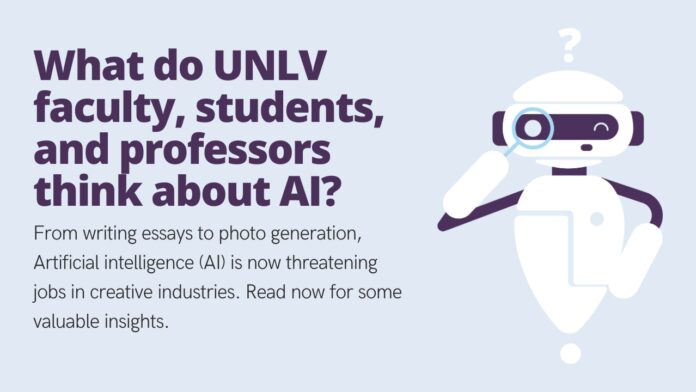“Artificial intelligence has replaced positions already.”
Artificial intelligence (AI) has made headlines — from essay writing to photo generation — and is now threatening jobs in creative industries. What do UNLV faculty, students and professors think about it?
Shahab Zargari is an administrative assistant at UNLV and a filmmaker. Zargari likens it to the fear that comes when new technology is introduced to the film industry, “Here’s a really good film example: When digital cameras first came out, [people were saying,] ‘Oh, no no no. You must shoot film on 35 millimeter film or on 16 millimeter film.’ And some of them still do and some of them want to go back to that, but most of TV and most of film, they’re being shot on digital cameras … So the digital camera came along, and did it kill film? No … If, like [digital cameras], we learned to adapt we learned to take it like a tool, I think we’ll be fine”
Sean Slattery, a UNLV fine arts professor, says, “All the AI is currently doing is imitating illustrative styles, and if it were my art that it were imitating, I’d be worried and upset with the companies, not with the technology itself, but with the companies. It’s good at doing certain things. It’s not really engaging in the conceptual art world yet. So, I can tell it, ‘Give me a cat sitting on a sink,’ but I can’t say, ‘Give me an artwork that makes me think.’ It’s not like AI is doing anything spectacularly interesting on its own, and it’s not doing anything spectacularly out of the ordinary. In fact, I would argue it’s as ordinary as most art.”
It can be more efficient in reducing the amount of time it takes to do visual effects (VFX) for a film. Zargari says, “It’s already happening. So here’s another film example: rotoscoping. So, if I were to film you and there was a green screen behind you? So, I’ll put a waterfall behind you. if I take this camera and I move it, but the background didn’t move, it looks completely fake, right? So, what they had to do and what they had to do in the past was to move it frame by frame. So, that’s 24 frames a second where I have to then move the background to look realistic. That takes forever, and that’s why on all these Marvel movies, there’s 17,000 VFX people … It’s not perfect because artificial intelligence is not intelligent. I can hit play. I can say, ‘Hey, this is my human. Track these eyeballs.’ I hit play and artificial intelligence tracks the whole thing. I have to fix it, I have to correct it because it didn’t really do everything clean, but I’ve just saved myself two days of work.”
There are some risks, however. Zargari says, “Where artists and filmmakers are getting nervous is with the strike and everyone saying, ‘Oh we’ll just get ChatGPT to make this script’ … The thing you have to remember is that artificial intelligence is not intelligent.” Slattery adds, “The ethical concern with people is people’s images being used to train [the AI] without their consent. That’s where I have issues with it.”
Nana Kwame Adjei-Brenyah, a fiction author who visited UNLV at the beginning of the semester, said, “I’m not an expert on the AI thing, but I can say that I think art that I’m interested in is about being human. It is about the human experience, so I can’t say I feel particularly threatened as an artist … I acknowledge that because there’s the corporate capitalist model that [relies on] consumption. It is always going to try to find a cheaper, easier way, but as artists, I don’t think we should be worried because I think what we’re actually doing is, not only being human, but being ourselves.”
Slattery has a different take, saying “I don’t know that I can distinguish between a human, as in a human-made artwork, versus an AI-made artwork … I don’t know that I see them as fundamentally different. I feel like we train ourselves differently than AI, but we also train ourselves in significantly similar ways. Like, I tell my students that you get better at art by looking at art and making art … If you don’t look at art all the time and if you don’t think about art all the time and make art all the time, the odds are you’re not going to become the top artist. And if you think about it, isn’t that what AI is doing? We’ve given it images to look at. We tell it to make art, and then we tell it, ‘This art is good’ and ‘This art is bad.’ And then, it comes back again and it’s like, ‘Wow.’ I mean, I know some people would argue [that there are] fundamental differences, but I feel like AI is kind of learning like we do. They say, ‘AI is a black box,’ but so are we.”
With AI being in such early stages of development, no one can predict how much this technology will impact creatives. In 10 years, the technology may not have changed much, but it could also change everything.

